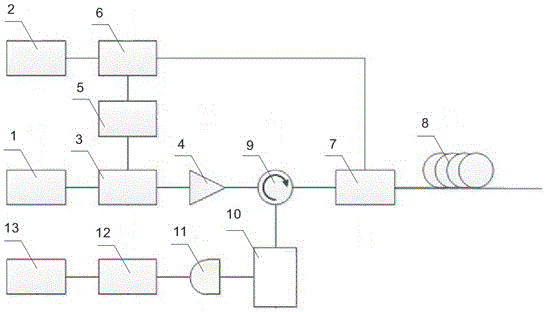Distributed Sensing System Based on Delayed Pulse Raman Amplification
A Raman amplification and sensing system technology, applied in the direction of using optical devices to transmit sensing components, can solve problems such as limiting sensing distance, reducing signal-to-noise ratio, modulation instability, etc., to extend sensing distance, nonlinear The cumulative effect is small, the effect of reducing the impact
- Summary
- Abstract
- Description
- Claims
- Application Information
AI Technical Summary
Problems solved by technology
Method used
Image
Examples
Embodiment
[0034] In order to illustrate the nonlinear effect caused by increasing the pump power more specifically, take a 50km G.652 optical fiber as an example. Because pulses of different wavelengths are transmitted at different speeds in the fiber, the 1550nm probe light and the 1455nm pump light have a group velocity mismatch. This characteristic leads to the walk-off phenomenon. The dispersion parameter is: Therefore, for the faster pump pulse to interact with the slower probe pulse, it is necessary to ensure that there is a certain delay in the pump pulse. Taking the time delay of 10ns as an example, the pump pulse will undergo stimulated Raman scattering with the detection pulse at 10km, thereby amplifying the detection optical signal. Such as figure 2 Shown is a schematic diagram of the interaction of the pump pulse with the amount of time delay with the probe pulse.
[0035]In order to further illustrate that the distributed sensing system based on delayed pulse Raman ampl...
PUM
 Login to View More
Login to View More Abstract
Description
Claims
Application Information
 Login to View More
Login to View More - R&D
- Intellectual Property
- Life Sciences
- Materials
- Tech Scout
- Unparalleled Data Quality
- Higher Quality Content
- 60% Fewer Hallucinations
Browse by: Latest US Patents, China's latest patents, Technical Efficacy Thesaurus, Application Domain, Technology Topic, Popular Technical Reports.
© 2025 PatSnap. All rights reserved.Legal|Privacy policy|Modern Slavery Act Transparency Statement|Sitemap|About US| Contact US: help@patsnap.com



